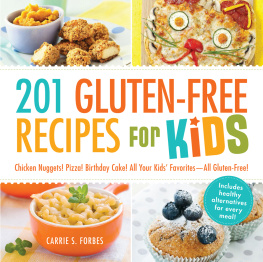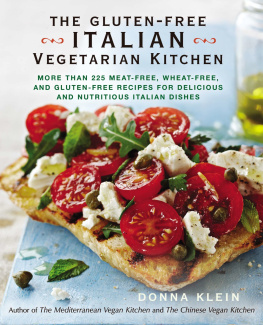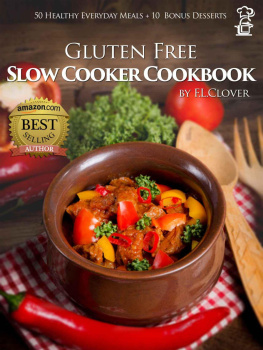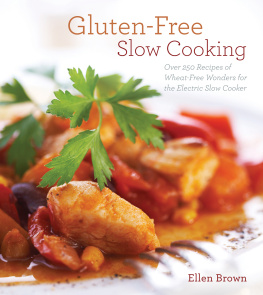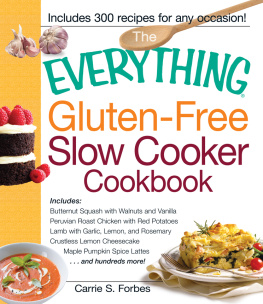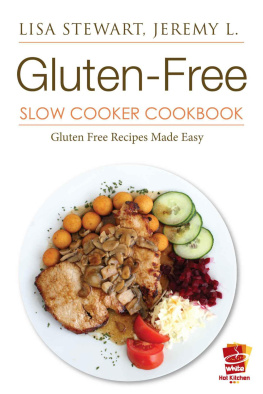201 GLUTEN-FREE
RECIPES FOR KIDS
Chicken Nuggets! Pizza! Birthday Cake! All Your Kids FavoritesAll Gluten-Free!
CARRIE S. FORBES

AVON, MASSACHUSETTS
DEDICATION
To owl-loving Madelyn and camo-rocking Kendall, two amazing young girls who taught me how tough and resilient little ones can be in the face of a life-changing celiac diagnosis. Because of that beautiful smile, Madelyn, Ive learned how important it is to make sure the parents of young celiac kids have access to a gluten-free support system and a recipe for good ol gluten-free cinnamon bun muffins.
INTRODUCTION
Switching to a gluten-free diet can be difficult. Switching your kids to a gluten-free diet can be even more difficult. One way to make the transition easier for themand youis by cooking up healthy gluten-free alternatives to their favorite meals. Whos going to miss the gluten when youre making pancakes in the morning, chicken noodle soup for lunch, pizza for dinner, and cupcakes for dessert? With all these options, you wont be switching them over, youll be winning them over with tasty dishes.
The decision to go gluten-free is one that more and more parents are choosing to make. In some instances, its because their children suffer from celiac disease or gluten intolerance, and cant have it as part of their diets. In others, its because they want to treat autism spectrum disorders holistically, or they want to help their children adopt healthier eating habits. Whatever your reasoning, making the decision to go gluten-free does not mean you have to sacrifice flavor or variety.
With 201 recipes, youre able to serve up kid-friendly food at every meal and have plenty on hand for snack time. Whether your kids are hungry for chicken nuggets or looking to munch on some chips, you can satisfy their cravings and feel good about what youre feeding them. Each recipe includes detailed yet easy instructions on how to whip up palate-pleasing food in no time. Youll forget youre preparing gluten-free food as quickly as theyll forget theyre eating it.
Throughout, youll also find helpful tips and tricks on how to successfully make that switch to a gluten-free lifestyle. In addition, the first chapter provides you with a more in-depth look at what it means to go gluten-free. With these recipes, hints, and additional information, you can turn your kitchen gluten-free with ease.
Making the transition to a gluten-free diet can be fun for the whole family. This book is meant to help you make that change and maintain that lifestyle. Now you can cook gluten-free meals your kids will love every day of the week!
CHAPTER 1
GLUTEN-FREE MADE EASY
This chapter will teach you how to find naturally gluten-free foods, how to spend less on your grocery bill for gluten-free foods, and how to prevent cross-contamination in your home kitchen.
GLUTEN DEFINED
Gluten is the term used for several types of proteins found in wheat, barley, and rye. The proteins gliadin and glutelin are found in these grains and together form a substance called gluten. Gluten is a storage protein, which means that it holds the key ingredients for these grains to continue proliferating.
Gluten is primarily found in foods like bread, pasta, cakes, muffins, crackers, and pizza dough. Wheat, barley, and rye are used in many baked goods because the gluten in these grains provides excellent elasticity, structure, and texture. Gluten is what causes pizza to have a chewy, stretchy texture. It gives French bread its soft white center and chewy crust. Gluten makes cinnamon rolls stretchy, soft, and light. It helps give structure to bread dough when rising, so that the bread becomes tall and stays tall after baking and cooling.
Avoiding gluten in your childrens diets can be difficult for several reasons. The biggest reason is that ingredients containing gluten are not required by law to be listed on food labels. However, by law, the top eight food allergens must be listed on every food label in the United States, and wheat (which is a primary source of gluten) is one of them. So although you may not see gluten in the ingredients list, you can look for food allergen information, for example, contains wheat.
When you are removing gluten from your childs diet, you will also need to avoid these foods (most are derivatives of wheat), which also contain gluten:
- Barley
- Rye
- Triticale (a cross between rye and wheat)
- Bulgur
- Durum flour
- Farina
- Graham flour
- Kamut
- Semolina
- Spelt
- Couscous
As a matter of fact, its often a good idea (especially when your child first receives a diagnosis of celiac disease) to only let them eat foods that are either naturally gluten-free, or actually are labeled gluten-free until you have a better understanding of how to read food and nutrition labels.
THE REAL DEAL ON CELIAC DISEASE AND GLUTEN SENSITIVITY
Celiac disease (also known as celiac sprue or gluten-sensitive enteropathy) is an auto-immune and digestive disorder that occurs in about one in 100 people in the United States. For children with this disorder, gluten can cause serious damage to their intestine if it is ingested. If your child has celiac disease or gluten sensitivity, gluten damages the villi in their intestines. Since the villi (finger-like projections that contain most of the enzymes needed for digestion) are damaged for those with celiac disease, their bodies have enormous difficulty ingesting the healthy nutrients their bodies need such as fat, calcium, iron, and folate.
Some of the symptoms of celiac disease and gluten sensitivity include:
- Digestive problems such as bloating, vomiting, excess gas and/or pain, severe and/or chronic diarrhea, irritable bowel, weight loss, weight gain, etc.
- Constant and/or severe headaches or migraines
- Low levels of iron (anemia)
- Skin rashes (also known as dermatitis herpetiformis)
- Bone or joint pain
- Depression and/or anxiety
- Seizures
- Unexplained fatigue
- Failure to thrive
Most children have a healthy immune system that prevents the body from being harmed by gluten, but for those with celiac disease the only effective treatment is avoiding foods with gluten altogether.
To get your child tested for celiac disease and/or gluten sensitivity you need to visit your family doctor or a gastroenterologist, who will do a blood test to check for high levels of certain types of antibodies. If his blood test comes back with positive results for celiac disease, the doctor may then choose to do a biopsy of his small intestine to check for damage to the villi. A diagnosis is usually given using a combination of these diagnostic tests. Gluten sensitivity (as opposed to celiac disease) is sometimes diagnosed if a patient tests negatively for the disorder, yet his or her body reacts with symptoms that are similar to those with celiac disease.
PLANNING FOR A GLUTEN-FREE LIFESTYLE
If your child has been diagnosed with celiac disease, the first thing you will want to do is gather all the information you can. Ask your pediatrician to recommend a nutritionist or registered dietitian who can give you a better understanding of what going gluten-free really means. A nutritionist may also request that your doctor order tests to help you discover if your child has any additional food sensitivities or nutritional deficiencies. These tests may include a bone scan or tests of vitamin D, calcium, iron, zinc, B12, folate, or thyroid levels. Once the doctor and nutritionist have a better picture of whats going on in your childs body, they can help determine the best plan of action and what gluten-free foods will be the most nutritious choices.

